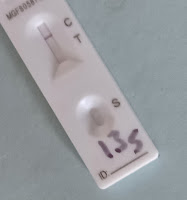 |
Another negative, day 5
|
Having had Omicron over the Christmas period, being fully boosted, and not being clinically vulnerable,
it looks like I have:
- Little chance of re-infection by Omicron (see footnote update)
- High immunity to Delta and earlier variants
- Little chance of serious infection should any of these variants be caught
The objective of this blog, as quoted in the header above, is "Applying business, scientific and IT expertise to get back to normality by defeating COVID-19 disease."
Subject to a future variant appearing which is serious and evades vaccination, this is the best immunity since the pandemic began. Does that mean such normality has been achieved? Freedom?
FREEDOM?
For me, I'd say yes. Freedom, at least whilst immunity lasts. The residual risk feels similar to the risk of crossing the road, or cycling, say. That residual risk is being tested, as explained below.
How about for younger adults, who have not yet had chance to be fully-vaced and boosted? Risks somewhat higher, but the chances of serious disease low. Almost as much freedom.
Would I go to a crowded nightclub, as an example of a hi-risk environment? Yes. Done it already, multiple times, as below. What about those not fully vaxed? They need to assess the risk personally according to the number of jabs they have had, level of clinical vulnerability, and attitude to risk.
Nightclubs and venues for similar events have been ensuring their premises are as safe as possible, to encourage patrons to attend. My experience is that there's been clear thought about ventilation, and it has been improved.
EXPERIMENT UPDATE
As noted here, there was the opportunity at New Year to test my immunity:
- To get out to a major crowded event for New Year's Eve (NYE)
- To throw an 8-hour all-nighter in a crowded sweaty night club the night after
Two potentially super-spreader events. Indeed I've heard of multiple infections at the NYE event. No news yet from the other event.
I'm pleased to report another negative Lateral Flow Test, which I need before my daily voluntary work. 'Freedom' will continue.
ONGOING PRECAUTIONS
That doesn't mean ignoring sensible precautions. Just like looking before crossing the road.
Masks, meeting outdoors, well-ventilated indoor spaces, and other basics worth continuing, even if no longer legally required. For your own protection, and to protect others if you do perchance get infected.
Kissing? That aunt who insists on it? Why not? Though the choice is yours.
UPDATE DAYS 6 & 7
Both day 6 and day 7 LFTs negative again, thankfully.
The experiment continues. Going in hard this coming weekend!
UPDATE DAYS 8, 9, 10 and 11
Day 7: First night done out clubbing, and enjoyed.
Day 8 LFT again negative, though tomorrow's will be more telling.
Day 9 negative.
Second night done out clubbing. Oh yes! Day 10 will be key.
Day 10 negative!
Day 11 negative. Experiment working, so far at least. Haven't caught any COVID variant, despite attending four potentially super-spreader events in the last 2 weeks.
Day 12 negative. We know positive results tend to occur within three days of infection, Looks virtually certain that neither Omicron nor Delta has been acquired from any of the four potentially super-spreader events attended in the last fortnight.
Day 14 negative.
Experiment successful. Immunity gained aginst Omicron and Delta by a combination of booster and having had Omicron.
FURTHER UPDATE
We're now into the third weekend. Last night was the fifth potentially super-spreader event.
Day 15 negative.
Last night was the sixth such event.
Day 16 negative.
Day 17 negative
Day 18 negative.
Day 19 negative
Another 2 hours at a potentially super-spreader event last night. The 7th. The experiment continues.
Day 20 negative.
A heavy weekend planned. Three hot sweaty super-spreader events done. Now 10 so far this year..
Day 21 negative
Day 22 negative
Day 23 negative, even with a little blood. But that's another story
5 more hot sweaty potentially super-spreader events done. Total of 15 so far in January since being back from Omicron infection on New Years Eve.
Day 24-33 negative
Days 34-36 negative, despite possibly fighting off second Omicron infection
If I die, I'll die happy. Which reminds me. Must get that Mini prepped for the RallyCross racing series.
UPDATE ON RE-INFECTION BY OMICRON
There is now evidence of people who have had Omicron being re-infected by it. Does that matter?
In terms of illness, it is unlikely to be more serious than the first infection. The issue is a practical one. A positive LFT means self-isolating for at least five full days, to avoid passing it to others.
Frankly that's a risk I'm prepared to take to get back to normal life.











































